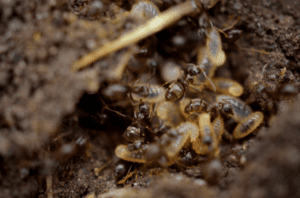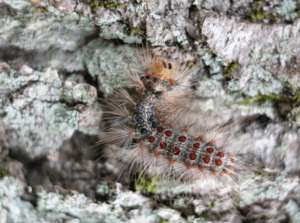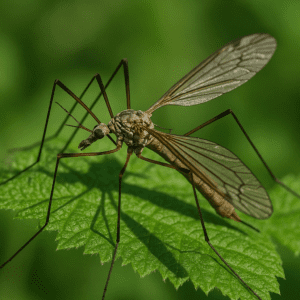
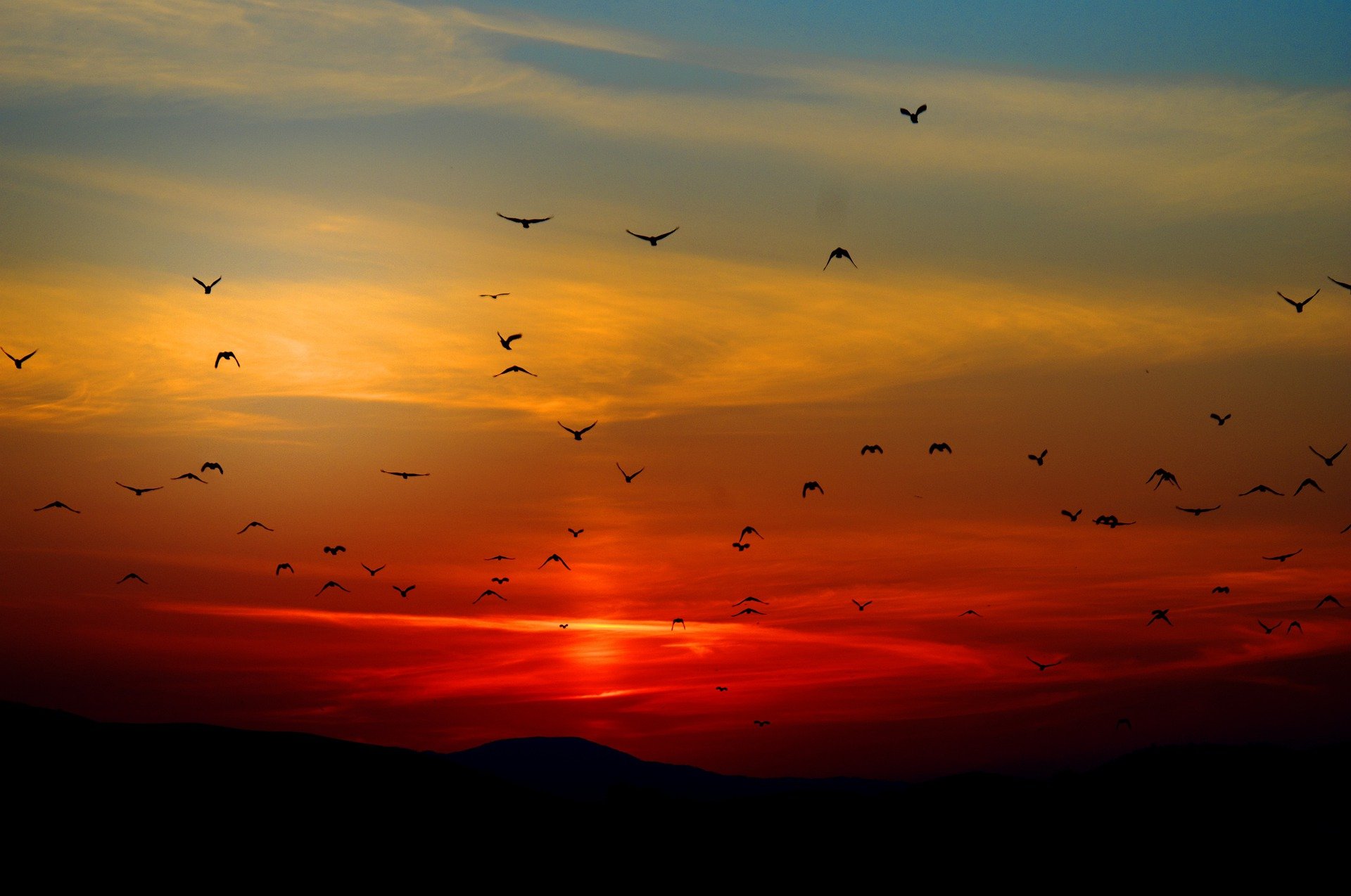
An incredible 480 different bird species live in New Jersey, which makes for some awesome birdwatching. We can’t cover all those species here (that would fill a book), so we’ve chosen five of the many birds you might have seen around the Garden State. We’ve also included a few birdwatching tips in case you’d like to spend some time appreciating these beautiful creatures.
 Snowy egrets owe their name to their brilliant white plumage, which contrasts with their black beaks and legs and bright yellow feet. During the breeding season, the males among these small, slender herons grow wispy feathers on their heads, necks, and backs. The males’ breeding season feathers were once a highly desirable fashion accessory, and the demand for them, unfortunately, led to the species becoming endangered. That said, times have changed, populations grew, and snowy egrets are no longer endangered.
Snowy egrets prefer aquatic habitats such as bays, marshes, ponds, and swamps, where they nest in colonies. They usually make their nests in mangroves, shrubs, or trees.
Fun Facts: Snowy egrets occasionally mate with other heron species, resulting in hybrid species. Mated pairs of the birds take turns incubating the eggs. The one that takes over the incubation gives its mate a stick. The parents continue to raise their young together after the eggs hatch.
Snowy egrets owe their name to their brilliant white plumage, which contrasts with their black beaks and legs and bright yellow feet. During the breeding season, the males among these small, slender herons grow wispy feathers on their heads, necks, and backs. The males’ breeding season feathers were once a highly desirable fashion accessory, and the demand for them, unfortunately, led to the species becoming endangered. That said, times have changed, populations grew, and snowy egrets are no longer endangered.
Snowy egrets prefer aquatic habitats such as bays, marshes, ponds, and swamps, where they nest in colonies. They usually make their nests in mangroves, shrubs, or trees.
Fun Facts: Snowy egrets occasionally mate with other heron species, resulting in hybrid species. Mated pairs of the birds take turns incubating the eggs. The one that takes over the incubation gives its mate a stick. The parents continue to raise their young together after the eggs hatch.
 Male northern cardinals are instantly recognizable, thanks to their bright red plumage, black masks, and black throats. While not as showy as the males, the females of the species have pale orange-brownish plumage with red highlights on the wings, tail, and breast. The males and females have short, thick bills and a crest on their heads.
These beautifully colored birds prefer living in areas that are dense with shrubbery. You have a good chance of spotting them in hedges, at the edges of forests, and in marshy thickets and overgrown fields. Some have even made their home in overgrown backyards.
Fun Facts: The northern cardinal is the state bird of seven different states, including Illinois, Indiana, Kentucky, North Carolina, Ohio, Virginia, and West Virginia. These birds become fiercely territorial during the breeding season. Some will even fight with their own reflections for hours because they think those reflections are intruders.
Male northern cardinals are instantly recognizable, thanks to their bright red plumage, black masks, and black throats. While not as showy as the males, the females of the species have pale orange-brownish plumage with red highlights on the wings, tail, and breast. The males and females have short, thick bills and a crest on their heads.
These beautifully colored birds prefer living in areas that are dense with shrubbery. You have a good chance of spotting them in hedges, at the edges of forests, and in marshy thickets and overgrown fields. Some have even made their home in overgrown backyards.
Fun Facts: The northern cardinal is the state bird of seven different states, including Illinois, Indiana, Kentucky, North Carolina, Ohio, Virginia, and West Virginia. These birds become fiercely territorial during the breeding season. Some will even fight with their own reflections for hours because they think those reflections are intruders.
 European starlings are stocky birds with long, narrow beaks and short tails. The colors of their plumage and beaks change with the seasons. In summer, European starlings’ feathers are a deep, glossy black with green-purple iridescence, and their beaks are yellow. In winter, the color of their feathers changes to brown with white spots, and their beaks get darker.
European starlings tend to nest and forage for food in urban and suburban areas. When looking for a habitat, they look for cavities that are big enough to build a nest in and for lots of open space where they can forage.
Fun Facts: European starlings can reach speeds of up to 48 miles per hour when they fly. Given their name, you probably suspect that they’re not native to New Jersey (or anywhere else in the U.S.). You’re right. The species was intentionally introduced to North America in the late 1800s when a group of Shakespeare fans thought it would be a good idea to bring every bird species mentioned by the English playwright to the U.S. They succeeded in establishing a population of European starlings when they released 100 of the birds in New York City’s Central Park in the early 1890s. All the European starlings in America are descendants of those birds.
European starlings are stocky birds with long, narrow beaks and short tails. The colors of their plumage and beaks change with the seasons. In summer, European starlings’ feathers are a deep, glossy black with green-purple iridescence, and their beaks are yellow. In winter, the color of their feathers changes to brown with white spots, and their beaks get darker.
European starlings tend to nest and forage for food in urban and suburban areas. When looking for a habitat, they look for cavities that are big enough to build a nest in and for lots of open space where they can forage.
Fun Facts: European starlings can reach speeds of up to 48 miles per hour when they fly. Given their name, you probably suspect that they’re not native to New Jersey (or anywhere else in the U.S.). You’re right. The species was intentionally introduced to North America in the late 1800s when a group of Shakespeare fans thought it would be a good idea to bring every bird species mentioned by the English playwright to the U.S. They succeeded in establishing a population of European starlings when they released 100 of the birds in New York City’s Central Park in the early 1890s. All the European starlings in America are descendants of those birds.
 The red-bellied woodpecker is bigger than most other birds you’ll see in your backyard. They’re stocky and they have long chisel-shaped beaks. Despite the name, the birds have white feathers with a faint red tint on their bellies. The feathers on their wings and backs have black and white zebra-like stripes. The males have a red marking on the neck that extends over the crown and down to the beak. On females, the red marking is only on the back of the neck.
Red-bellied woodpeckers prefer to live in wooded areas where they will find numerous hickory, oak, and pine trees.
Fun Facts: Male and female red-bellied woodpeckers have different tongues, which might allow them to forage for food in different places. Both males’ and females’ tongues have barbs on the end, and their tongues can extend almost 2 inches past the end of their beaks. Plus, their saliva is sticky. All these factors make it easy for these birds to forage for food in cracks, crevices, and holes.
The red-bellied woodpecker is bigger than most other birds you’ll see in your backyard. They’re stocky and they have long chisel-shaped beaks. Despite the name, the birds have white feathers with a faint red tint on their bellies. The feathers on their wings and backs have black and white zebra-like stripes. The males have a red marking on the neck that extends over the crown and down to the beak. On females, the red marking is only on the back of the neck.
Red-bellied woodpeckers prefer to live in wooded areas where they will find numerous hickory, oak, and pine trees.
Fun Facts: Male and female red-bellied woodpeckers have different tongues, which might allow them to forage for food in different places. Both males’ and females’ tongues have barbs on the end, and their tongues can extend almost 2 inches past the end of their beaks. Plus, their saliva is sticky. All these factors make it easy for these birds to forage for food in cracks, crevices, and holes.
 Sharp-shinned hawks are small birds with tails that are long and square-tipped. Some birds’ tails have a notch in the end. Their chest and belly have rust-colored stripes, their tail is white with black bands, and their head and back are a blue-gray color.
These hawks live in forested areas as they breed in dense forest. They often build their nests in conifer groves near clearings where they can hunt for food.
Fun Facts: Songbirds are a favorite food of sharp-shinned hawks. These hawks carry songbirds they caught to a perch and pluck all the feathers off. They do this because, unlike owls, they don’t eat their prey’s feathers. Before migrating in the fall, sharp-shinned hawks gather in huge numbers in various places. In October one year, more than 11,000 sharp-shinned hawks were seen in Cape May Point, New Jersey.
Sharp-shinned hawks are small birds with tails that are long and square-tipped. Some birds’ tails have a notch in the end. Their chest and belly have rust-colored stripes, their tail is white with black bands, and their head and back are a blue-gray color.
These hawks live in forested areas as they breed in dense forest. They often build their nests in conifer groves near clearings where they can hunt for food.
Fun Facts: Songbirds are a favorite food of sharp-shinned hawks. These hawks carry songbirds they caught to a perch and pluck all the feathers off. They do this because, unlike owls, they don’t eat their prey’s feathers. Before migrating in the fall, sharp-shinned hawks gather in huge numbers in various places. In October one year, more than 11,000 sharp-shinned hawks were seen in Cape May Point, New Jersey.
Snowy Egret
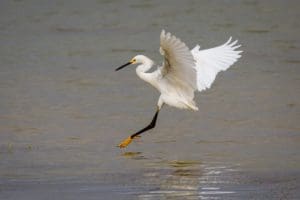 Snowy egrets owe their name to their brilliant white plumage, which contrasts with their black beaks and legs and bright yellow feet. During the breeding season, the males among these small, slender herons grow wispy feathers on their heads, necks, and backs. The males’ breeding season feathers were once a highly desirable fashion accessory, and the demand for them, unfortunately, led to the species becoming endangered. That said, times have changed, populations grew, and snowy egrets are no longer endangered.
Snowy egrets prefer aquatic habitats such as bays, marshes, ponds, and swamps, where they nest in colonies. They usually make their nests in mangroves, shrubs, or trees.
Fun Facts: Snowy egrets occasionally mate with other heron species, resulting in hybrid species. Mated pairs of the birds take turns incubating the eggs. The one that takes over the incubation gives its mate a stick. The parents continue to raise their young together after the eggs hatch.
Snowy egrets owe their name to their brilliant white plumage, which contrasts with their black beaks and legs and bright yellow feet. During the breeding season, the males among these small, slender herons grow wispy feathers on their heads, necks, and backs. The males’ breeding season feathers were once a highly desirable fashion accessory, and the demand for them, unfortunately, led to the species becoming endangered. That said, times have changed, populations grew, and snowy egrets are no longer endangered.
Snowy egrets prefer aquatic habitats such as bays, marshes, ponds, and swamps, where they nest in colonies. They usually make their nests in mangroves, shrubs, or trees.
Fun Facts: Snowy egrets occasionally mate with other heron species, resulting in hybrid species. Mated pairs of the birds take turns incubating the eggs. The one that takes over the incubation gives its mate a stick. The parents continue to raise their young together after the eggs hatch.
Northern Cardinal
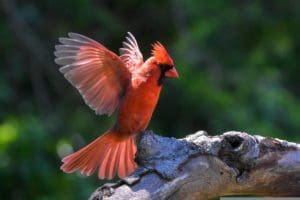 Male northern cardinals are instantly recognizable, thanks to their bright red plumage, black masks, and black throats. While not as showy as the males, the females of the species have pale orange-brownish plumage with red highlights on the wings, tail, and breast. The males and females have short, thick bills and a crest on their heads.
These beautifully colored birds prefer living in areas that are dense with shrubbery. You have a good chance of spotting them in hedges, at the edges of forests, and in marshy thickets and overgrown fields. Some have even made their home in overgrown backyards.
Fun Facts: The northern cardinal is the state bird of seven different states, including Illinois, Indiana, Kentucky, North Carolina, Ohio, Virginia, and West Virginia. These birds become fiercely territorial during the breeding season. Some will even fight with their own reflections for hours because they think those reflections are intruders.
Male northern cardinals are instantly recognizable, thanks to their bright red plumage, black masks, and black throats. While not as showy as the males, the females of the species have pale orange-brownish plumage with red highlights on the wings, tail, and breast. The males and females have short, thick bills and a crest on their heads.
These beautifully colored birds prefer living in areas that are dense with shrubbery. You have a good chance of spotting them in hedges, at the edges of forests, and in marshy thickets and overgrown fields. Some have even made their home in overgrown backyards.
Fun Facts: The northern cardinal is the state bird of seven different states, including Illinois, Indiana, Kentucky, North Carolina, Ohio, Virginia, and West Virginia. These birds become fiercely territorial during the breeding season. Some will even fight with their own reflections for hours because they think those reflections are intruders.
European Starling
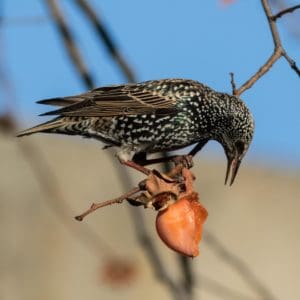 European starlings are stocky birds with long, narrow beaks and short tails. The colors of their plumage and beaks change with the seasons. In summer, European starlings’ feathers are a deep, glossy black with green-purple iridescence, and their beaks are yellow. In winter, the color of their feathers changes to brown with white spots, and their beaks get darker.
European starlings tend to nest and forage for food in urban and suburban areas. When looking for a habitat, they look for cavities that are big enough to build a nest in and for lots of open space where they can forage.
Fun Facts: European starlings can reach speeds of up to 48 miles per hour when they fly. Given their name, you probably suspect that they’re not native to New Jersey (or anywhere else in the U.S.). You’re right. The species was intentionally introduced to North America in the late 1800s when a group of Shakespeare fans thought it would be a good idea to bring every bird species mentioned by the English playwright to the U.S. They succeeded in establishing a population of European starlings when they released 100 of the birds in New York City’s Central Park in the early 1890s. All the European starlings in America are descendants of those birds.
European starlings are stocky birds with long, narrow beaks and short tails. The colors of their plumage and beaks change with the seasons. In summer, European starlings’ feathers are a deep, glossy black with green-purple iridescence, and their beaks are yellow. In winter, the color of their feathers changes to brown with white spots, and their beaks get darker.
European starlings tend to nest and forage for food in urban and suburban areas. When looking for a habitat, they look for cavities that are big enough to build a nest in and for lots of open space where they can forage.
Fun Facts: European starlings can reach speeds of up to 48 miles per hour when they fly. Given their name, you probably suspect that they’re not native to New Jersey (or anywhere else in the U.S.). You’re right. The species was intentionally introduced to North America in the late 1800s when a group of Shakespeare fans thought it would be a good idea to bring every bird species mentioned by the English playwright to the U.S. They succeeded in establishing a population of European starlings when they released 100 of the birds in New York City’s Central Park in the early 1890s. All the European starlings in America are descendants of those birds.
Red-Bellied Woodpecker
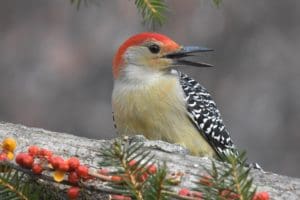 The red-bellied woodpecker is bigger than most other birds you’ll see in your backyard. They’re stocky and they have long chisel-shaped beaks. Despite the name, the birds have white feathers with a faint red tint on their bellies. The feathers on their wings and backs have black and white zebra-like stripes. The males have a red marking on the neck that extends over the crown and down to the beak. On females, the red marking is only on the back of the neck.
Red-bellied woodpeckers prefer to live in wooded areas where they will find numerous hickory, oak, and pine trees.
Fun Facts: Male and female red-bellied woodpeckers have different tongues, which might allow them to forage for food in different places. Both males’ and females’ tongues have barbs on the end, and their tongues can extend almost 2 inches past the end of their beaks. Plus, their saliva is sticky. All these factors make it easy for these birds to forage for food in cracks, crevices, and holes.
The red-bellied woodpecker is bigger than most other birds you’ll see in your backyard. They’re stocky and they have long chisel-shaped beaks. Despite the name, the birds have white feathers with a faint red tint on their bellies. The feathers on their wings and backs have black and white zebra-like stripes. The males have a red marking on the neck that extends over the crown and down to the beak. On females, the red marking is only on the back of the neck.
Red-bellied woodpeckers prefer to live in wooded areas where they will find numerous hickory, oak, and pine trees.
Fun Facts: Male and female red-bellied woodpeckers have different tongues, which might allow them to forage for food in different places. Both males’ and females’ tongues have barbs on the end, and their tongues can extend almost 2 inches past the end of their beaks. Plus, their saliva is sticky. All these factors make it easy for these birds to forage for food in cracks, crevices, and holes.
Sharp-Shinned Hawk
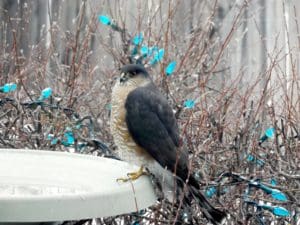 Sharp-shinned hawks are small birds with tails that are long and square-tipped. Some birds’ tails have a notch in the end. Their chest and belly have rust-colored stripes, their tail is white with black bands, and their head and back are a blue-gray color.
These hawks live in forested areas as they breed in dense forest. They often build their nests in conifer groves near clearings where they can hunt for food.
Fun Facts: Songbirds are a favorite food of sharp-shinned hawks. These hawks carry songbirds they caught to a perch and pluck all the feathers off. They do this because, unlike owls, they don’t eat their prey’s feathers. Before migrating in the fall, sharp-shinned hawks gather in huge numbers in various places. In October one year, more than 11,000 sharp-shinned hawks were seen in Cape May Point, New Jersey.
Sharp-shinned hawks are small birds with tails that are long and square-tipped. Some birds’ tails have a notch in the end. Their chest and belly have rust-colored stripes, their tail is white with black bands, and their head and back are a blue-gray color.
These hawks live in forested areas as they breed in dense forest. They often build their nests in conifer groves near clearings where they can hunt for food.
Fun Facts: Songbirds are a favorite food of sharp-shinned hawks. These hawks carry songbirds they caught to a perch and pluck all the feathers off. They do this because, unlike owls, they don’t eat their prey’s feathers. Before migrating in the fall, sharp-shinned hawks gather in huge numbers in various places. In October one year, more than 11,000 sharp-shinned hawks were seen in Cape May Point, New Jersey.
Tips For Birdwatching
Follow these birdwatching tips if you want to improve your chances of seeing more birds:- Be quiet: Loud noises startle birds easily, and they will flee. Be as quiet as possible to get as close as possible.
- Avoid sudden movements: Sudden movements also startle birds. Keep as still as possible. If you need to move, do so slowly and quietly.
- Get the sun behind you: If possible, position yourself so that the sun is behind you. This makes it easier to spot and identify birds.
- Wear dark, neutral clothing: Wearing clothing with darker colors or earth tones makes it easier for you to blend into the background. Clothing that’s white or brightly colored will contrast with your surroundings and enhance your movements, making it easier for birds to see you (and probably get startled).
- Take note of habitat: Each bird species has adapted to a specific habitat. Do some research and take note of the habitats you visit so you can get an idea of which birds you might see.




